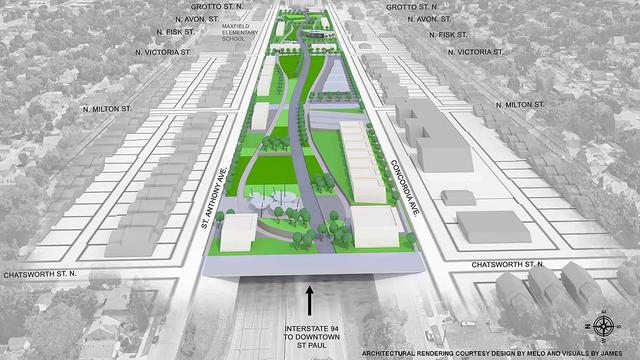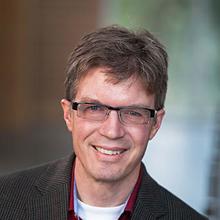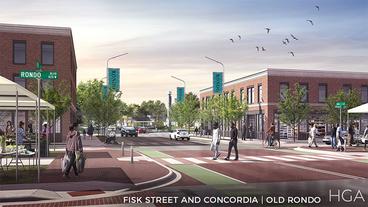By Sophie Koch
Highway projects in the United States have a long-standing history of dividing thriving minority communities to make way for vehicle travel. In recent years, there has been renewed interest, political willpower, and funding to address historical wrongs and repair divided communities.
However, these efforts need to be directed carefully—with equitable planning and community engagement—to avoid repeating old mistakes, according to researchers at the Humphrey School of Public Affairs.
Frank Douma, director of State and Local Policy and Outreach, and urban and regional planning student Maya Sheikh studied one approach: developing the rights-of-way and airspace near state highways.
They found that if the community is included in the planning process, infrastructure innovations ranging from land bridges over highways to under-bridge development, or even highway removal, can support both community health and economic growth.
One such land bridge project is under discussion in the Rondo neighborhood of St. Paul, an African American community that was divided by the construction of Interstate 94 in the 1950s and 1960s.
For their research, funded by the Minnesota Department of Transportation (MnDOT), Douma and Sheikh conducted eight case studies in communities across the nation to examine how public and private resources were used—to greater and lesser effect—to improve the land surrounding highways. They compiled best practices and presented their findings in an online symposium in August.
Speakers provided their on-the-ground perspectives of case studies from the Twin Cities, Atlanta, Milwaukee, and Washington, DC, as well as a review of national trends.
Cities have traditionally been built with the intention of delivering vehicle traffic directly into the heart of the city as fast as possible, said Peter Park, associate professor adjunct at the University of Colorado and a former city planner for Milwaukee and Denver.
However, Park said, highways tend to make city blocks bigger, limit access, widen streets, increase redundant travel, and overall reduce the performance and capacity of a transportation system. With infrastructure aging out, he said, there is now an opportunity to rebuild with people—not cars—in mind.
Engaging the community’s needs
First and foremost, Douma and Sheikh said planners must recognize that infrastructure alone cannot be relied upon to fix community wounds. “A lot of these cases come from situations where infrastructure caused the issues that we see,” Douma said.
Engaging and addressing the interests of local and surrounding communities is important for mitigating unintentional damage, Sheikh added, as is having a transparent governance process.
One concept for reconnecting land on either side of a highway is a “cap”—basically a wide bridge that can be enhanced with green space, foot travel access, and other features.
Keith Baker, executive director of ReConnect Rondo, presented his organization’s proposal to build a cap or land bridge over I-94 to reconnect the divided halves of the Rondo community.
A study done by ReConnect Rondo found that around 700 homes were destroyed when I-94 was built through the neighborhood, leading to an intergenerational wealth gap of -$157 million in unrealized home equity value as of 2018.
The Rondo land bridge, which would cost around $459 million, could potentially free up 21 acres for various types of development, and add around 1,800 new jobs to the area. Baker said it will be important to ensure that community input be taken into account as the project progresses.
“We see the early principle of community ownership as critical for driving transportation investment,” Baker said. “Again, we’re talking about righting past wrongs.”
Returning value to the community
A related best practice is to ensure that the funds generated by improvement projects return to the affected communities.
Gentrification is a significant issue that needs to be considered, as “improvement” projects will often increase property values in an area and drive out local residents who can’t afford rising housing costs.
Officials who are working on freeway projects in Georgia and Washington, DC, said they are working to engage the local communities and place control of the land back into the hands of the people living in the affected areas.
Douma concluded that community engagement is one of the most important aspects of remedying the harms of past infrastructure projects. “If one starts by trying to sell a vision rather than by understanding the community’s vision, you will likely run into some problems.”
---
Adapted from a story originally published by the Center for Transportation Studies




